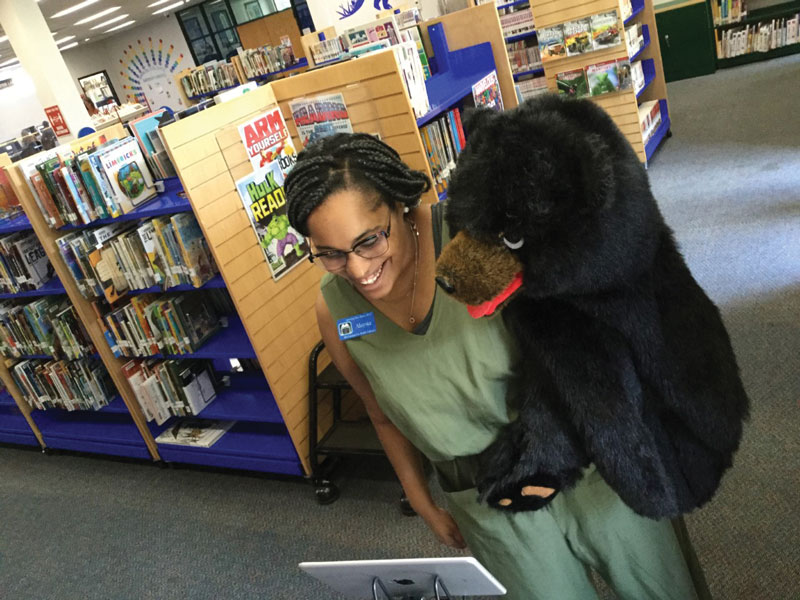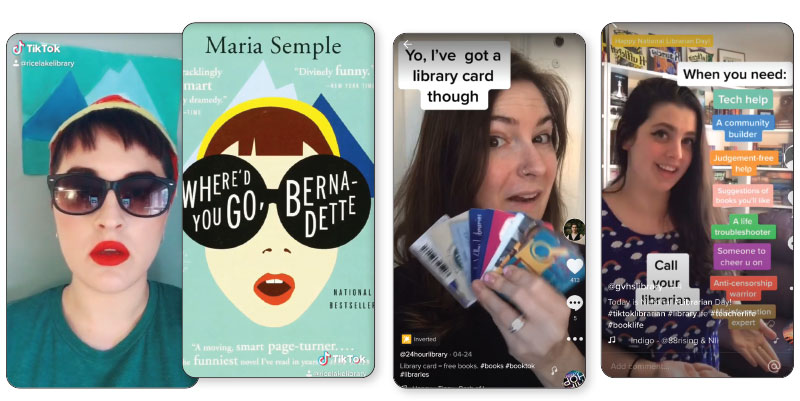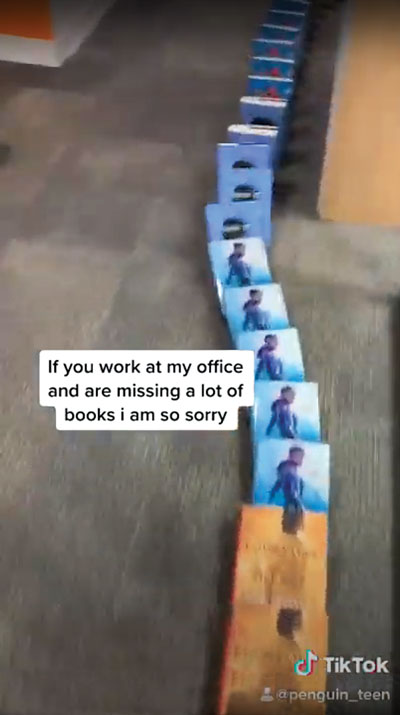What Makes These Librarians TikTok?
Meet kids where they are—on the red-hot video-sharing app.
 |
Alaysia Hamilton, youth services assistant at McCracken County (KY) Public Library (@mclibdotnet),
|
TikTok is having a moment, especially among teens. Following in the footsteps of Vine, which was discontinued in 2016, the free social media app allows users to create and share short videos using an array of sounds, filters, and tools. Over 40 percent of TikTok users in 2019 were between 16 and 24, according to web market research company GlobalWebIndex.
Unlike much of Instagram, TikTok isn’t about perfection. It’s about having fun, playing around with trends, and low-pressure sharing.
Another big appeal factor for TikTok, in addition to its ease of use, is that it allows for endless content discovery. Users can spend hours scrolling through videos from the app’s “For You” page. As with other social media, reacting with likes, comments, and shares is straightforward. Bonus: TikTok lets users partake in memes, as well as try out a “duet,” which allows users to create their own video reaction or re-creation side-by-side with another video.
TikTok hasn’t been without controversy. Developed by a Chinese company, the app has raised concerns about cyber security and handling of user data. The U.S. Army and Navy banned TikTok on government phones, and Wells Fargo told employees to delete the app from work devices. There are also concerns about TikTok deleting or muting videos, given the Chinese government’s stance on social media.
That hasn’t dampened young peoples’ enthusiasm for the platform, including activists. TikTokers made headlines for reserving thousands of tickets to a June Trump rally in Tulsa, OK, they didn’t use. Considering the platform’s explosive popularity and the need to connect with teens where they are, librarians may want to learn about TikTok firsthand and try it out.
 |
Above left: Making a TikTok for the Rice Lake (WI) Public Library (@ricelakelibrary). Center: A video from the @24hourlibrary account encourages library card signup. Right: Kelsey Bogan, media specialist at Great Valley (PA) High School, promotes library services at @gvhslibrary. |
More library,
|
Why TikTok?
“When students first introduced me to TikTok and asked me to make one for the library, I immediately saw it as a valuable advocacy, branding, and community-building tool that I could leverage for my library program,” says Kelsey Bogan, librarian at Great Valley (PA) High School (TikTok @gvhslibrary).
As with any social media, the decision to explore your library’s presence and potential on TikTok should be informed by your community. Teens don’t hang out on Facebook, and their presence on Twitter and Instagram has been shrinking. TikTok is a place where they can be themselves. Libraries can consider this mindset to reach the kids they serve.
“It’s cool how easy it is to edit together a creative video without being a professional or having fancy editing software,” says Lindy Liedl, library assistant at Rice Lake (WI) Public Library (RLPL; TikTok @ricelake-library). “Gen Z has probably watched a lot of YouTube creators who have to use pricey software to create content, but now these creators and their viewers are creating content with quick, funny, or beautiful ideas and talents with relative ease.”
Another TikTok perk: Videos created there can be easily shared on other social media and automatically saved on your device. They don’t disappear in a set time frame, and the effects and music stick with the video outside TikTok.
Abby Hargreaves, a youth services librarian who runs the popular @24hourlibrary book TikTok account, advocates using TikTok not just to reach out to teens, but to stay abreast of what teens are into at any given moment.
“Using TikTok in an authentic way that shows you’re actually interested in [the platform] can go such a long way toward building a relationship, just like any genuine shared interest. And you’ll never know what you’ll learn thanks to someone else’s video,” she says. “It’s hyper-immediate, which can make it difficult to keep up with, but can also be a huge benefit for proving your trendy credentials to the ones in control of the trends—teens and tweens.”
How to get started
As with any other social media your library uses, developing a plan is crucial. Consider where and how the account will be housed, who will oversee creating and sharing content, and the kinds of content you’ll want to include. Create a personal account first to get a feel for it, scope out content of other libraries and librarians, and play around.
In other words, dive in and explore. TikTok allows you to follow accounts and view new videos from those accounts in your “Home” feed. You can search the platform using hashtags or keywords, then branch out to individual accounts. The “For You” page’s algorithm suggests videos you might like to scroll through. Your interactions with other accounts can impact what you see, so the more you like and comment on accounts, the more that feed can help you discover similar content.
“TikTok is one of those things that’s difficult to explain and only really makes sense after you’ve immersed yourself,” Bogan says. “After you spend time in the app as a consumer, you start to get a feel for it, and inevitably you start to think of ideas of videos you’d like to create.”
The biggest piece of advice librarians have shared about successfully using TikTok goes for any social media account. Success happens through consistency.
“There are so many different ways to film these videos that you want to make sure that if you have a team [managing the account], everyone is on the same page,” says Alaysia Hamilton, youth services assistant at McCracken County (KY) Public Library (TikTok: @mclibdotnet). “To gain likes and followers, posting almost daily is important. But the videos don’t always have to be long and thought out. They could be [about] a short and funny trend that you see.”
Browsing and liking the other videos by libraries and librarians can be helpful in idea generation, adds Claire Parrish-Lane, public services director at the RLPL. You don’t have to reinvent the wheel; just add your own spin. Parrish-Lane’s library creates weekly TikTok videos to keep the account engaging without demanding significant staff time.
One challenge, though, is that it can be hard to measure success or engagement. The algorithm favors videos that lean into popular hashtags or audio sounds. (Note, however: TikTok has one of the most complex algorithms in social media, often favoring pretty people and shadow banning accounts with political statements.) For Hamilton, measuring the success of a TikTok video is facilitated when that video is shared on other social media platforms, where likes, comments, and shares are easier to understand.
The best measure of success, though, isn’t necessarily in numbers, but the ability to create content that does a lot of work in a short time.
“TikTok has been especially powerful for helping me reach my library advocacy goals because it provides a very engaging, often humorous, format for conveying messages about the value of the modern library,” Bogan says. “It provides a lot of opportunity to create content that highlights the great things libraries do, or to create content that shatters stereotypes or misconceptions about libraries and librarians.”
 |
When Penguin Teen (@penguin_teen) launched its TikTok in 2019, the publisher never planned to use it as a book catalog, but rather a place to have fun. A TikTok of lined-up books falling, domino-style, went viral. |
Encouraging engagement
With such vast possibilities for content creation, where do you begin? As with most things teen, content that’s relatable is always popular, as is swiftly hopping aboard trends. Since you don’t have to be polished or perfect on TikTok—that’s discouraged—there’s freedom to try things out and see what works, or doesn’t.
“Following trends and memes is very important. Your content will get more engagement if you keep up with the trending sounds on TikTok, and the trends change rapidly,” says Bogan. “One week, you may notice everyone using the same sound. You should try to create a video using that popular sound too!”
“Another week, you may notice tons of people are trying to do the same choreographed dance,” Bogan adds. “Jump on the bandwagon and give it a shot. Putting your own spin on something, or making fun of the fact that you can’t do it, is also a way to engage.”
Bogan’s experience suggests that videos with faces tend to do better than those without, and shorter videos emphasizing humor, irony, or offering a surprise generate greater engagement.
Act fast: “Be aware of how quickly memes and trends go through the app. A meme generating tons of views on other videos will probably flop if you wait until next week to do yours,” Hargreaves says.
“‘Authenticity’ doesn’t necessarily mean ‘serious’ or ‘the deepest parts of yourself,’” she adds. “If I giggle at a meme and decide to repurpose it in a bookish context because it made me laugh, that’s authentic.”
Successful TikToks involve flexibility, understanding your audience, authenticity, and using the STAR technique (situation, task, action, result) for building a story, Hargreaves notes.
Hargreaves found that employing this popular interview method has been key, as it focuses on telling a story. Her most successful videos involve just that: stories, whether she’s highlighting books or offering short tutorials.
A craft tutorial, for example, will state a situation (e.g., you need to make an inexpensive gift); a task (make a personalized mug filled with candy for under $6); the actions to do that (steps to personalizing the mug and dressing it up as a gift); and the result (an image of the end product).
“Even the meme videos tell a whole story if you look closely enough,” she adds. “I avoid being too intentional about this, because then it just comes off as awkward and inauthentic. But the STAR technique can be a great guideline if you feel like your video is missing something.”
Don’t be intimated to play around, either. Nothing gets posted automatically, meaning that you have plenty of opportunity to edit, refilm, add filters or text, or try things out again and again until you’re ready to share.
New users should know not all TikTok content is PG or PG-13. Keep this in mind while scrolling your “For You” feed or hashtags—you might see or hear things that don’t align with your organization’s goals. Fortunately, your followers won’t see what you see unless you choose to share it. Also, note that there isn’t a way to repost or directly share another person’s video to your profile.
Have fun with TikTok! You’ll see why it’s gained tremendous traction with young people—and adults.
Best PracticesFind and follow book, library, and publisher TikToks to get inspiration. Don’t worry about doing something similar. Be humorous, authentic, and allow yourself to have fun with music, dancing, or simple tutorials. Develop a list of favorite sounds while scrolling. Click the song circle on the bottom of the screen to take you to a page with other videos using that sound. Click the “add to favorites” bookmark icon. When you want to use that sound for a video, it’ll be easy to find. Organizations should be cautious who they follow back. If a user following you has a private account, take pause. They might prefer privacy (or be a teenager who feels weird being followed by their library). Do follow other libraries, publishers, and organizations freely! Keep your hashtags specific, but not too specific. #Libraries is likely more effective for discovery than using your own library’s name in a hashtag. Popular TikTok hashtags for book-related accounts include #booktok, #librariansoftiktok, and #bookclub. Hashtags like #tiktoklibrarian and #tiktokteacher can help you connect with educators. Respond to comments on your videos, and leave comments and like the videos for accounts you follow. While making videos, use good, natural lighting when possible. Practice and be prepared to have some videos be big flops. TikTok is like any other social media: Not everything will land with your audience, and that’s ok. YouTube and Google searches can be helpful in explaining some TikTok tools. Struggling with how to time text to your video or use certain filters? Someone has likely made a handy tutorial on that. Let yourself be silly. This is about fun and authenticity as a means of sharing content and promoting what it is your library has to offer. |
Author Kelly Jensen lives in Woodstock, IL.
RELATED
The job outlook in 2030: Librarians will be in demand
The job outlook in 2030: Librarians will be in demand
ALREADY A SUBSCRIBER? LOG IN
We are currently offering this content for free. Sign up now to activate your personal profile, where you can save articles for future viewing






Add Comment :-
Be the first reader to comment.
Comment Policy:
Comment should not be empty !!!